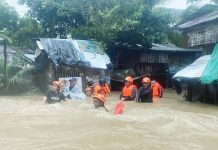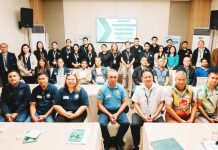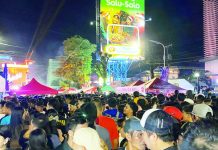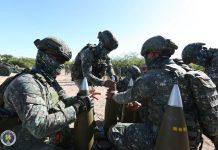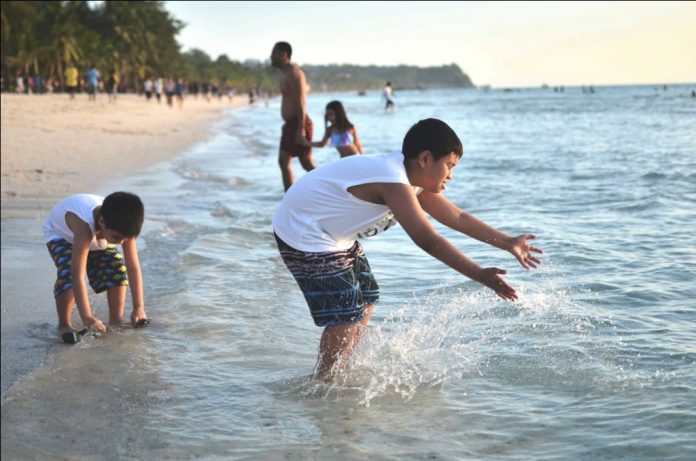
BORACAY – What should be done so that this island resort can sustain the gains from its six months of rehabilitation? “Be responsible tourists.” Tourism secretary Bernadette Romulo Puyat issued this public appeal as she officially declared Boracay open to tourism activities once more.
“It is the key to the preservation of this national treasure,” she said yesterday at Cagban Jetty Port in Barangay Manoc-manoc where the reopening ceremony was held.
“Welcome back to Boracay! Or would it be better to say, welcome back, Boracay?” she asked the crowd that included tourists, residents, owners and employees of hotels, resorts and restaurants, among others.
The Cagban port, the main gateway to Boracay, was chosen as venue of the ceremony as a symbol of the island welcoming visitors once again to enjoy its natural beauty.
What happened to Boracay, according to Puyat, “is the ultimate lesson in balancing development and protecting the environment.”
“The lessons learned here are not for Boracay alone but also for the other island destinations around our beautiful country. The reopening of Boracay is not the culmination of our journey on sustainable tourism — it’s just the beginning,” according to the Tourism secretary.
Environment secretary Roy Cimatu agreed with Puyat. “I want to see a change in behavior and a change in culture from those coming here because they think they can do anything here. That should not be,” he said.
During the 10-day dry run for the island’s reopening from Oct. 15 to 25, Puyat said people would come up to the members of the Boracay Inter-Agency Task Force (BIATF) and say, “This shoreline, the beachfront we are seeing now, this is the Boracay they fell in love with 30 years ago.”
The BIATF is composed of the departments of Tourism, Environment and Natural Resources, Public Works and Highways, Interior and Local Government, Transportation, and Energy.
One of the highlights of the island’s reopening was the unveiling of a huge selfie wall, envisioned to become a “Boracay icon.”
POLITICAL WILL
“Congratulations, everyone, for a job well done. Our concerted efforts have proven once again that change is indeed possible with strong political will, as our dear President Duterte has exhibited, and eagerness to work together for the love of country,” said Puyat.
Duterte ordered Boracay’s closure in April for a massive rehabilitation after describing the island as having degenerated into a cesspoll due to untreated wastewater.
“I would like to acknowledge and thank our stakeholders for their patience, support and cooperation during the six-month rehabilitation. For our accredited establishments, and those who are working hard to be 100 percent compliant, thank you for your efforts to ensure the highest quality for hospitality and the environment,” said Puyat.
She was referring to 157 accommodation establishments – which have 7,308 available rooms to host tourists – that were initially accredited by BIATF in time for the reopening.
“The reopening of Boracay is not just the culmination of our journey on sustainable tourism. Together, let us ensure that future generations, our children and our children’s children, will still say it’s more fun in the Philippines,” said Puyat.
Aklan governor Florencio Miraflores, meanwhile, said “sacrifices had to be made” during the shutdown but they were “worth it.”
“The past six months was difficult for Aklan. The impact had been huge but now behind us,” he said.
Boracay Island was Aklan’s biggest source of revenues. There was a dramatic economic slowdown when it was closed.
Environment secretary Cimatu said BIATF is continuously accepting applications for compliance of hotels and resorts that are not yet accredited.
ECO WARRIORS
Over a hundred members of the “Kaligkasan” community multipliers group – a project of the Philippine National Police – which will augment government personnel in enforcing environmental laws in Boracay, also took their oath during the reopening program. They were from the three villages of Boracay – Balabag, Manoc-manoc and Yapak.
Thirty-two environmental law enforcers of the Department of Environment and Natural Resources which dubbed their group “Lawin” also took oath. They would be patrolling the beach.
“There will be a lot of laws and ordinances to be enforced in Boracay to make sure there will be no repeat of what happened,” said Interior and Local Government secretary Eduardo Año.
It will take about two years to complete the island’s rehabilitation, he stressed.
“Boracay is now very fresh and very orderly but there are still a lot of things to be done for the next two years,” said Año.
BIATF earlier directed all residents and establishments to set up and use properly functioning sewerage treatment plants via clustering or separate treatment plants to keep Boracay’s waters safe from wastewater.
Año reiterated added that only those establishments that have been accredited by the Departmetn of Tourism and cleared by the task force as fully compliant with local and environmental laws, such as the Environmental Compliance Certificate or Certificate of Non-Coverage, are allowed to re-open.
The “no floating structure” ban within three kilometers from the shoreline is also still in effect as part of the campaign to protect the beaches of Boracay./PN

